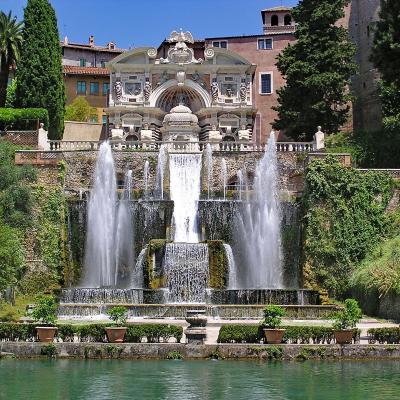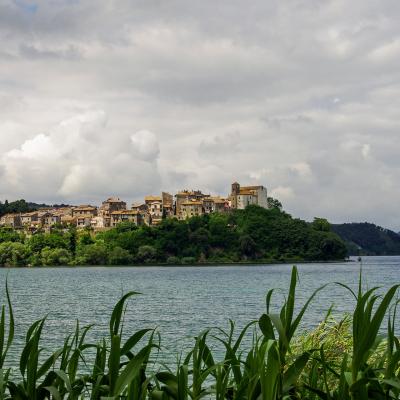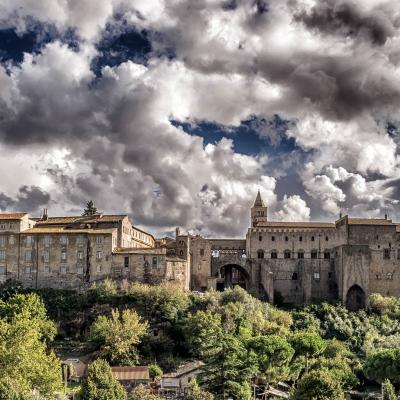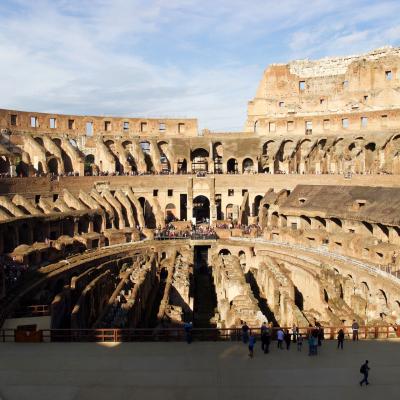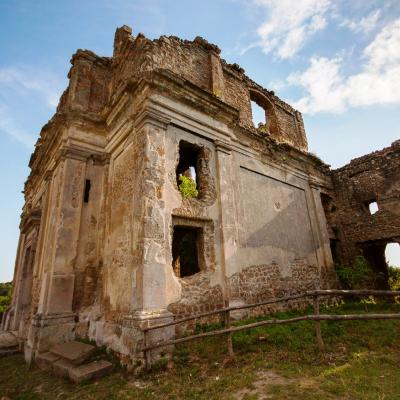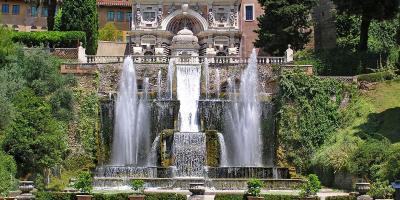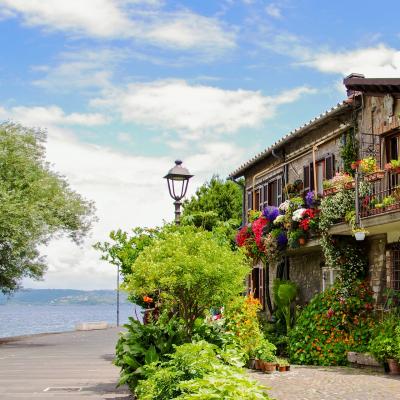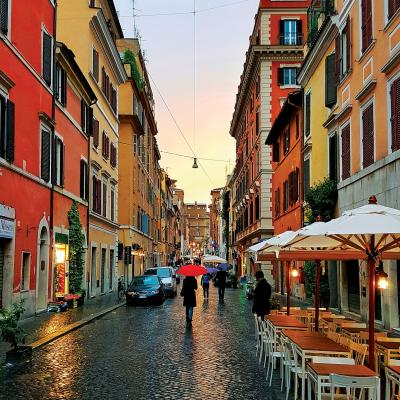Latium
A concentration of natural beauty, historical evidence and variety of flavors to be discovered make Lazio, beyond Rome, a special region that allows you to go back in time. Washed by the Tyrrhenian Sea and traversed by the waters of the Tiber River, it is characterized by a predominantly hilly and mountainous terrain. The coast is low and sandy, and the climate is temperate almost all year round. Latium features the small enclave of Vatican City, the seat of the Papal States and a destination for pilgrims from around the globe. Rome, the capital of Italy and the Eternal City, is world famous for its rich archaeological and artistic heritage from all eras.
What to see and what to do
In the territory of Latium there are several mountain groups that reach modest altitudes but with interesting physical characteristics for mountaineering enthusiasts, some of volcanic origin such as the Volsini Mountains, the Cimini Mountains and the Sabatini Mountains. In each of these groups there is a lake: Lake Bolsena on the Volsini, Lake Vico on the Cimini and Lake Bracciano on the Sabatini.
The Alban Hills are also of volcanic origin, and there are also lakes here that are also of volcanic origin: Lake Albano and Lake Nemi.
Lesser known are the Ruffi Mountains, while the Affilani Mountains, which overlook the highlands of Arci Milazzo, are often chosen for short trips. Simple walks and challenging routes, by choice, in the Prenestini Mountains, where it is possible to climb the Guadagnolo walls at the foot of the Mentorella shrine.
100 kilometers from Rome, near Rieti, is Mount Terminillo, where there is one of the largest ski complexes in the Apennines frequented in winter but also in summer.
Visiting the capital, the Colosseum and the Via dei Fori Imperiali are the first stops par excellence. Continue by following the Lungotevere to Castel Sant'Angelo, the mausoleum of Emperor Hadrian, not forgetting the many basilicas and churches scattered throughout. Rome is home to the country's major institutions, famous squares such as the Spanish Steps and Piazza Navona, not to mention the 18th-century Trevi Fountain, where tourists toss a coin as a wish to return to the Eternal City. Archaeological sites can be found throughout the region: from the Temple of Jupiter Anxur in Terracina, to the Roman excavations in ancient Ostia, from the Etruscan necropolis in Cerveteri, to Hadrian's Villa in Tivoli, where Emperor Hadrian lived (UNESCO Sites).
Latium offers landscapes that contrast and complement each other, untouched natural scenery and spectacular horizons enclosed between urban centers. Visitors can delve into havens of extraordinary beauty even within city walls: an example is Villa Borghese in Rome, the most famous city park where one can stroll, even by bicycle. Also not to be missed are the medieval villages, especially Anagni, Civita di Bagnoregio, Calcata and Ninfa. Latium is also a spa region: the Romans built sumptuous thermal baths, such as the Terme di Caracalla, in Fiuggi. Sea lovers will not be able to stay away from authentic pearls such as Gaeta, Sabaudia, Sperlonga and the small archipelago of the Pontine Islands
The Sea
The Latium coastline is interesting and varied-rocky contracts, long beaches, intricate cliffs. Barren and sandy in the north, where the mouth of the Chiarone ditch marks the border between the provinces of Grosseto and Viterbo, here the coastline is characterized by the presence of the Montalto di Castro tower, the WWF oasis of Vulci and the Tarquinia salt marshes, a nature reserve for the protection of seagulls and flamingos. The giant red-and-white smokestack of a power plant, which can be spotted from afar, characterizes Civitavecchia, in every era the focus of military interests because of the strategic importance of its port, now a landing point for Sardinia.
Tourist marinas are at Riva di Traiano and Santa Marinella.The low, sandy shoreline continues to Fregene, a resort with a reputation for elegance; continuing on one encounters the less touristy, Fiumicino, which is Rome's river port and then Ostia lido. Rich in vegetation near Castel Porziano, the coastal strip continues flanked by a succession of establishments, bars and restaurants to the tuff promontory on which Anzio is located. Further south, with the Circeo promontory in the background, lies Sabaudia, a town with elegant geometric profiles. The coast continues still low and without ports as far as Terracina and the promontory of Sperlonga.
Clean and isolated beaches follow one another, such as Monte Ciannito, the Grotta delle Bambole and Aeronauta near Gaeta , to the right of whose promontory is the renowned Serapo beach. The Latium coastline is continuous low and sandy until the rocky promontory of Scauri, beyond which is the sandy shore and pine forest of marina di Minturno.
Between the islands of the Ponzian archipelago, Ponza welcomes visitors to its 18th-century harbor, surrounded by pink and white cottages. Zannone can be reached from San felice Circeo only as part of guided tours; the island of Ventotene is also very beautiful.
Parks
In recent years, with the intent to protect natural environments and important ecological balances but also areas of historical and cultural interest, 24 protected areas of landscape interest have been established in the Lazio region- Among them are the Simbruini Mountains Regional Nature Park, the Nature Reserves laghi Reatini, in the southern part of the province of Latina, between the limestone reliefs of the Aurunci Mountains and the Tyrrhenian coast is the Regional Suburban Park of Gianola and Monte di Scauri, here the WWF organizes guided tours of the marine reserve throughout the year. Also in the province of Latina is the Circeo National Park, which has four integral nature reserves and since 1977 its forest has been recognized by UNESCO as a biosphere reserve.
Lakes
Latium has numerous lakes mostly of volcanic origin: Bolsena, Bracciano, Vico, Albano and Nemi, not forgetting the lesser-known Mazzano, Monterosi, Martignano, Giulianello and Posta Fibreno; they have generally clear waters are ideal for a relaxing vacation. Each offers special attractions: in Lake Bolsena are the beautiful Martana and Bicentina islands. Lake Vico is located within the nature reserve and is equipped with an equestrian center, a sailing and rowing center, and many trails for walking, horseback riding, or biking. Lake Bracciano is a paradise for those who love sailing while Lake Martignano offers horseback riding enthusiasts the chance to ride a truly scenic route.
Terme
From north to south, from Viterbo to Suio Terme, Lazio's healing resorts boast ancient origins. In the province of Rome, the waters at the Tivoli baths municipality are famous, named for the cerulean, opalescent appearance of the liquid; they were anciently called santissime because of their therapeutic power. Near Lake Bracciano are the thermal baths of Vicarello, also known to the Etruscans. The thermal baths of Stigliano, located in the municipality of Canale Monterano, must while, iIn the province of Frosinone, in the center of the ciociaria, is Fiuggi, a very famous spa town: the therapeutic qualities of its waters, famous for the treatment of calculosis, have been known since the Middle Ages, when the miraculous waters, cured Pontificio Bonifacio VIII from whom the baths took their name. South of Cassino are the Varronian baths, while in the Sacco valley are the Pompeian baths. In the province of Latina, almost on the border with Campania, are the waters of the Suio baths; in the province of Rieti are the Cottorella springs. Three kilometers from Viterbo lies a large thermal area, known as Terme dei Papi, which has its center in the spring of Dante's Bullicame.
What to eat
Laziale's gastronomy is very tied to the land and based on strong and savory flavors, typical of central Apennine Italy. It draws its origins from folk traditions where it was necessary to make do with what the land had to offer. As pasta first courses, bucatini all'amatriciana, rigatoni alla carbonara, penne all'arrabbiata, rigatoni alla vaccinara, and fregnacce are certainly among the most famous in national gastronomy. They are followed by saltimbocca alla romana (made with veal, ham and sage), porchetta dei Castelli Romani, and dishes based on abbacchio and vegetables. The latter is cooked in a variety of ways: roasted, as scottadito ribs, alla cacciatora, and with artichokes. As for fish, highly prized is pike from Lake Bolsena, prepared with tomatoes and capers, along with cod in guazzetto.
It is worth mentioning mozzarella DOP and pecorino romano DOP as characteristic products of the region. The most classic traditional Roman dessert is maritozzo, a soft bun with pine nuts, raisins and candied orange peel. Bocconotti are small shortbread cakes stuffed with ricotta cheese. Particularly tasty is pangiallo, a dessert made with walnuts, almonds, hazelnuts, pine nuts and honey. Finally, Lazio Turismo boasts 25 DOC appellations to accompany the tasty dishes of traditional cuisine. Some of these are: the Aprilia, Aleatico di Gradoli, the wines of the Castelli Romani and Colli Albani, and the Est! Est! Est! of Montefiascone.
